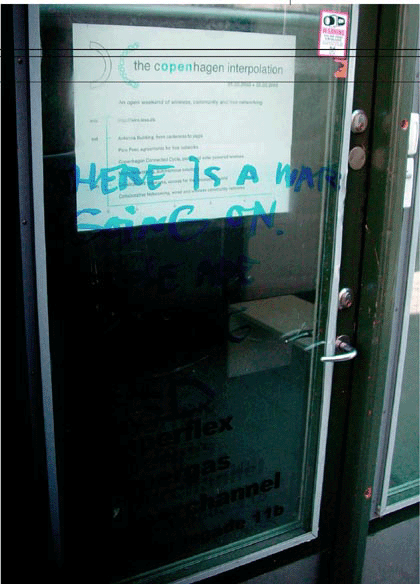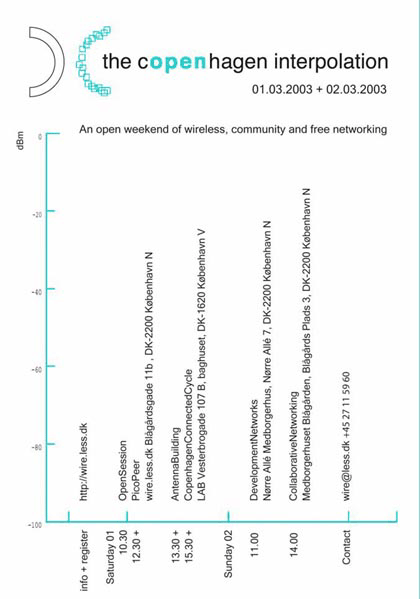The Copenhagen Interpolation
Saul Albert attends the latest meeting on free wireless networks in Copenhagen and discovers a difference in focus that may allow commercial and non-commercial operations to co-exist, if not cooperate
According to local sources Copenhagen has a population of 1.7 million people and 3 million bicycles. Unloved and unlocked, the rusting rejects lie in great bike-drifts by the sides of wide kerbs, huddled around bus shelters or the sides of buildings. Unbelievably, bicycle theft has risen by 50 percent in the last year; from seven bikes in 2001 to a grand total of 14 bikes stolen in 2002. While Denmark no doubt has its share of social problems, the gross economic inequality suffered by many European states does not seem to be one of them.
In general, this poverty gap and by extension, the widespread inequality of access to technology, connectivity and information, is the problem that Free Networkers have always sought to address: creating low-cost, unmetered local networks using recycled technology, unlicensed radio spectrum, and Free Software to build their own information systems rather than relying on expensive and often dysfunctional government or commercial products. Apparently, connectivity (as well as equipment and training) is easily and cheaply available in Copenhagen, so it may seem strange that in March 2003 wireless network hobbyists from around the world gathered there for the Copenhagen Interpolation to discuss the future of Free Networking.[1]
 >> Copenhagen Interpolation by Saul Albert
>> Copenhagen Interpolation by Saul Albert
During this series of workshops and conferences (organised by wire.less.dk[2] and informal[3]), it quickly became clear that the agenda of this meeting was far more complex and challenging than the initial ‘cheap internet connectivity’ focus of early ‘community wireless networks’[4] which, in cities like Copenhagen, has become somewhat redundant since the roll out of more or less affordable and fairly reliable broadband. Although more technically focused activities such as antenna building[5], war driving and network visualisation[6] were well represented at the meeting, they were grounded firmly within the political and social research that has often been something of a sideshow to gatherings of Free Networkers.
For example, the Development Networks workshop organised by Tomas Krag addressed the idea and logistics of creating low-cost wireless networks in developing countries. Tomas talked about his experiences in Ghana working with Geekcorps[7], a charity that assigns highly-skilled volunteer techies to companies in poor areas, which brought up difficult and fundamental questions for Free Networkers such as whether ‘universal access’ (the aim of many Free Network projects) is a worthwhile goal in itself, and to what extent giving assistance without giving ‘aid’ is possible in direly underdeveloped economies, whether in Zanzibar or Hackney[8].
The Mesh Networking session, a demonstration by Richard Lander from Locustworld[9] about non-centralised, dynamically routable networks of small nodes began as a technical demonstration of the very tasty Locustworld Mesh AP system: a relatively cheap standalone appliance, or a free to download bootable CD image that can harmlessly re-purpose your computer as a mesh network access point in minutes. But after drooling over the tech, the discussion turned equally enthusiastically to social and legal issues of meshed networking such as how to assign names and IP numbers, whether de-centralised IP and DNS allocation is necessary or even possible, and crucially how ‘free’ the Free Software used by Locustworld actually is[10].
The encouraging result of these discussions was that without any reductive drive to consensus, paths through these technical and social problems did begin to emerge, and during the continuous ‘Pico Peering’ debate, that process was further consolidated by the development of a useful, shared definition of the ‘Free’ bit in ‘Free Networks’. The Pico Peering Agreement (PPA)[11], a kind of template Gnu Public License (GPL)[12] for Free Networks was initiated during the Berlon Free Networks meeting in November 2002.[13] It set out to provide a sustainable theoretical framework for the expansion of the Free Network.
The idea is simple: huge corporate network owners such as MAE West in the US, or Linx in London, charge smaller companies and, through a trickle-down process, individuals for the transit of data across their networks. Rather than charge each other to exchange data at ‘network borders’, they create ‘peering agreements’: contracts by which they agree to exchange data between their networks without charging each other. By creating a Pico (as in tiny) Peering Agreement (PPA), individuals who own network equipment – even just a single computer connected (wired or wirelessly) to another free networker’s computer – can do the same. By enforcing their right of ownership and stating that they reserve the right to allow unmetered transit of data across their tiny part of the network, they can create their own Free Network.
 >> Graffiti by Julian Priest
>> Graffiti by Julian Priest
Although this might sound simple, disentangling the intricate social, legal and technical issues involved in Free Networks and then distilling them into the PPA proved a hugely challenging process, particularly due to the large and diverse development group. But the release of version 1.0 of the document in human-readable form (following the model of the Creative Commons licenses, machine-readable and lawyer-readable versions are planned[14]), is a vital contribution to a growing understanding of Free Networks as a ‘commons’[15], a communally owned resource of information transit.
This view of the Free Network explains why the interest in Free Networks persists in relatively privileged environments . Although it may be cheap and simple to rent DSL, which comes slightly closer to ‘free’ in the sense of ‘gratis’, the ‘free’ as in ‘libre’ of a commonly owned and run resource is literally priceless. The consolidation of commercial operations in the 2.4Ghz spectrum in the form of ‘hotspots’ in hotels, airports and coffee chains, is not as threatening as it first seemed. These commercial strategies continue to focus on wireless internet access. The Free Network, as defined by documents such as the PPA, has an entirely different and unique potential: to be a viable and economically competitive supplement to the internet, but one where the system of ownership is decentralised enough for it to remain a ‘commons’.
 >> Copenhagen Interpolation flyer
>> Copenhagen Interpolation flyer
[1] See [http://wire.less.dk/wiki/index.php/CopenhagenInterpolation ] [2] A Danish company that provides wireless networks and education to commercial and non-commercial organisations, including low-cost networks for developing countries. See [http://wire.less.dk. ][3] An international association for social and technological development and multidisciplinary collaborative research. See [http://informal.dk ] and [http://informal.co.uk ][4] Rob Flickenger’s book: Building Wireless Community Networks (Sebastopol, CA: O’Reilly & Associates, 2002) is a good example of this, in which the specific ‘wireless’ technology is bound to the vague political abstraction ‘community’ completely uncritically[5] See [http://guerrilla.net/gnet_2_4ghz.html ] for some great DIY 2.4 GHz antenna construction tips[6] War Driving involves collecting data about wireless network activity in a given area by driving around with a laptop, ‘sniffing’ for it, see [http://www.havenworks.com/vocabulary/a-z/w/war-driving/ ], and then plotting that data onto a map, see [http://www.ittc.ku.edu/wlan/ ][7] See [http://www.geekcorps.org ][8] Interestingly, some of the workshops were held in the Danish art group Superflex’s HQ. They faced similar issues in developing their Supergas project, a low-cost bio-gas system for export to poor farmers in the developing world, see [http://www.superflex.dk/tools/supergas/ ][9] See [http://locustworld.com ][10] Quite free as it turns out. There is an issue with the license for the AODV component of their system, which may become proprietory, but that apart all Locustworld’s code is licensed under the GPL[11] See [http://picopeer.net ][12] GNU Public License, one of the ‘copyleft’ devices that keeps Free Software in the public domain. See [http://www.gnu.org/copyleft/gpl.html ]13 See Simon Worthington’s write up on Metamute.com, ‘Libre, non Gratis: BerLon’ [http://picopeer.net/dox/libre.php ]14 See [http://creativecommons.org ]15 For the Wireless Commons Manifesto, a call to arms for Free Networkers by Adam Shand of the [http://www.personaltelco.net ] project, see [http://www.wirelesscommons.org ]
Saul Albert –– text-code-admin –– current: Cartographic Congress [http://uo.twenteenthcentury.com/index.php/CartographicCongress ], recent: [http://traffic-island.co.uk ], archive: [http://www.twenteenthcentury.com/saulcv ]
Mute Books Orders
For Mute Books distribution contact Anagram Books
contact@anagrambooks.com
For online purchases visit anagrambooks.com








